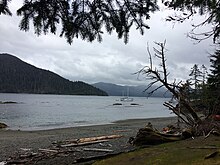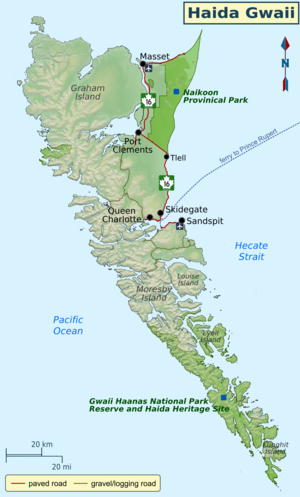Haida Gwaii (Islands of the People), previously known as the Queen Charlotte Islands, and before that as "Xhaaidlagha Gwaayaai" or “Islands at the Boundary of the World," are in British Columbia, Canada. Though the archipelago comprises over 150 islands, the two largest, Graham and Moresby, dominate the visitor's itinerary.
Settlements
[edit]- 1 Daajing Giids-Skidegate — neighbouring settlements of Daajing Giids (formerly Queen Charlotte) and Skidegate; the arrival point for ferries from the Mainland, and main tourist centre
- 2 Masset — the main settlement at the north end of the islands, and the site of three ancient Haida villages
- 3 Sandspit — the main jumping off point for those flying in from Vancouver and for those wanting to explore Gwaii Haanas National Park Reserve
Other destinations
[edit]- 1 Gwaii Haanas National Park Reserve — the remains of a Haida village on the eastern side of the island represent an outstanding example of a traditional Northwest Coast First Nations village site
- 2 Naikoon Provincial Park — nearly 70,000 ha of lush rainforest and sandy beaches
Understand
[edit]This is a remote area where there are few big chain stores or high end amenities. Do not expect grand resorts choked with tourists. The Haida House resort owned by the Haida is on the Tlell River, and there are B&Bs, cabins, and motels that offer accommodations. Some of the reasons to come to the islands are to explore the outdoors as there are numerous options for hiking, hunting, beachcombing, kayaking, and fishing. Other visitors enjoy the many artisan galleries that can be found.

The Haida Gwaii have been called “The Misty Islands”, referring to the moist, mild climate, and to the mystique of its inhabitants, the Haida Nation. The Haida have a highly developed seafaring culture and had a reputation for adventure, 20-metre dugout canoes, fascinating ceremonies and ferocious exploits. The art of the Haida Nation is famous throughout the world. Majestic and intriguing cedar totem poles and carvings, argillite statuary and intricately designed woven baskets and hats of spruce root were once representations of a clan’s wealth and prestige. These and many items were frequently given away at potlatches to help cement the socially complex kinship system.
In 1787 Captain George Dixon surveyed the islands. He named the islands the Queen Charlotte Islands after his ship, the Queen Charlotte, which was named after Charlotte of Mecklenburg-Strelitz, wife of King George III of the United Kingdom.
In 2010, the BC government renamed the Queen Charlotte Islands "Haida Gwaii", meaning "islands of the people".
History
[edit]Haida Gwaii is considered by archaeologists as a possibility for a Pacific coastal route taken by the first humans migrating to the Americas from the Bering Strait. At this time Haida Gwaii was likely not an island, but connected to Vancouver Island and the mainland via the now-submerged continental shelf.
It is unclear how people arrived on Haida Gwaii, but archaeological sites have established human habitation on the islands as far back as 13,000 years ago. Populations that had inhabited Beringia expanded into northern North America after the Last Glacial Maximum. Underwater stone structures discovered in 2014 on the seabed of Hecate Strait may date back 13,700 or more years, and be the earliest known signs of human habitation in Canada.
The group of people inhabiting these islands developed a culture made rich by the abundance of the land and sea. These people became the Haida. The Haida were a matriarchal society – the women made the decisions prior to European discovery. The Haida are a linguistically distinct group, and they have a complex class and rank system consisting of two main clans: Eagles and Ravens.

Diversity within the Haida Nation was gained through a cross-lineal marriage system between the clans. This system was also important for the transfer of wealth within the nation, with each clan reliant on the other for the building of longhouses, the carving of totem poles and other items of cultural importance. Noted seafarers, the Haida occupied more than 100 villages throughout the islands. The Haida were skilled traders, with established trade links with their neighbouring First Nations on the mainland to California.
The archipelago was discovered by Europeans in 1774 by Juan Pérez, at Langara Island, and in 1778 by James Cook. In 1794, the Haida captured and sank a pair of European vessels, Ino and Resolution, that were seeking to trade for sea otter pelts. Most of the ships' crew were killed. In 1851, the Haida captured the Georgiana, a ship carrying gold prospectors, and held its crew for ransom for nearly two months.
The islands played an important role during the maritime fur trade era of the late 18th and early 19th centuries. During most of that era the trade in the islands was dominated by Americans. The Oregon Treaty of 1846 put an end to American claims to the islands. Following the discovery of gold in the 1850s the British made efforts to exclude whatever American territorial claims might remain.
Flora and fauna
[edit]The islands are home to the Ta'an Forest, with a wide variety of large endemic trees, including the Sitka spruce, western red cedar, yellow cedar (Nootka cypress), shore pine, western hemlock, mountain hemlock, and red alder.
Soils are variable. Peat is common in poorly drained flats and even on sloping ground in the wetter areas. Kiidk'yaas (Golden Spruce), a naturally occurring genetic-variant yellow-colour Sitka spruce tree, was near the Yakoun River, the largest on Graham Island. It was a popular tourist attraction until it was illegally cut down in 1997 as a protest against the industrial logging practices.
From the spring of 1996 until November 30, 1997 a popular attraction for tourists to the islands was the male albino 'White Raven'. He lived around Port Clements and would commonly be seen taking food handouts from locals and visitors alike. He died after making contact with an electrical transformer. The White Raven was preserved by former Port Clements residents, taxidermists Roger Britten Sr. and Jr., and is on display in the Port Clements Historical Society's museum.
Climate
[edit]
The climate of this temperate northern hemisphere forested region, like that of much of the British Columbia and Alaskan coast in the area, is moderated by the North Pacific Current, with heavy rainfall and relatively mild temperatures throughout the year.
In the relatively shielded areas around Tlell and Sandspit annual rainfall averages from 1,200 millimetres (47 in) to 1,400 millimetres (55 in). Snowfall is generally moderate, averaging from 10 cm (4 in) to 70 cm (28 in), though at northerly Langara Island it averages around 100 cm (40 in).
Precipitation is typically extremely frequent, occurring on around two-thirds of all days even in relatively shielded areas, and direct sunlight is scarce, averaging around 3 to 4 hours per day.
Talk
[edit]The official language is English. Some Haida words have entered the lexicon.
Get in
[edit]By plane
[edit]Airports within this region with scheduled commercial flights
[edit]- Masset (ZMT IATA) - daily flights from Vancouver operated by Pacific Coastal Airlines
- Sandspit (YZP IATA). daily flights from Vancouver operated by Air Canada flies into Sandspit from Vancouver
Seaplanes
[edit]Ocean Pacific Air, ☏ +1-250-624-5879, toll-free: +1-844-228-9229, oceanpacificair@gmail.com. Operates charter seaplane flights between Prince Rupert and Haida Gwaii.
By ferry
[edit]- BC Ferries, toll-free: +1-888-223-3779. Operates ferries connecting coastal communities.
- 1 Graham Island (Skidegate) ferry terminal, #1 Hwy 16, Skidegate Landing.
- Vehicle ferry from Prince Rupert ferry terminal (7 to 8 hours crossing) on the North Coast, departing once per day 4 to 6 days per week. Some of these crossings may travel overnight.
- 1 Graham Island (Skidegate) ferry terminal, #1 Hwy 16, Skidegate Landing.
Some travelers may wish to take the scenic Inside Passage route from Port Hardy in North Vancouver Island. This is a 2-day trip, departing from Port Hardy, sailing 16 to 22 hours up the scenic coast of British Columbia to Prince Rupert. From Prince Rupert you will catch a second ferry to the Haida Gwaii. Reservations are strongly recommended as space is limited and the summer months are busy.
Get around
[edit]By boat
[edit]- BC Ferries, toll-free: +1-888-223-3779. Operates ferries connecting coastal communities.
- Operates vehicle ferries between Graham Island (Skidegate) ferry terminal and 2 Moresby Island (Alliford Bay) ferry terminal, crossing in 20 minutes. Ferries depart every 1 to 2 hours.
By car
[edit]The islands have developed highway infrastructure, and the Yellowhead Highway (Highway 16) travels from Skidegate to Masset on Graham Island. There are also numerous vehicle rental companies on island, and most communities have their own taxi services. If these options don't work for you, try sticking out your thumb. Hitch hiking isn't uncommon here.
See
[edit]- Haida Gwaii totem poles. See the remnants of the Haida people in these totem poles still standing in their original locations. The youngest dates from the 1850s (not counting the one made in 2017 for Canada's sesquicentennial). The biggest group is in the Haida village of Ninstints within Gwaii Haanas National Park Reserve, which is flanked by 26 totem poles.

- The Haida Heritage Centre in Skidegate is the premier cultural centre and museum of the Haida people and described as "a place for the Haida voice to be heard."
Do
[edit]Haida Gwaii is the site of some excellent sport fishing opportunities. Salmon weighing over 50 lb (23 kg) and halibut ranging to over 100 lb are routinely caught. There are also many hiking trails throughout the Islands, with most being easily accessible. The Visitor Centres on Island have information and maps for such activities. Visitor Centres can be found in Sandspit, Queen Charlotte, and Masset.
Eat
[edit]Traditional seafood, such as salmon, halibut, herring roe on kelp, razor clams, and seaweed. Herring roe on kelp, called "k’aaw," is among the most highly valued foods in the Haida community.
Drink
[edit]Stay safe
[edit]A lot of great beaches, lakes, and camping grounds can be accessed via logging roads. As they are active, visitors are strongly recommended to check road access at a local visitors centre.



